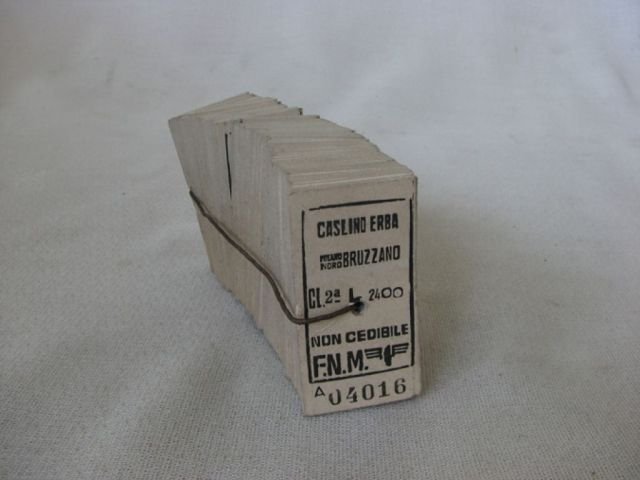EDMONSON ORDINARY SECOND-CLASS TICKET

-
Item owner - FNM
-
Category - FNM Collection
-
Inventory - 0633
-
Author - Ferrovie Nord Milano
-
Dimensions - 5.6x3 cm
-
Dating - 1900-1990
A04016 standard Edmonson card ticket with central perforation.
This type of ticket was used for over 100 years, not only by Ferrovie Nord and the national railways, but by other European transportation systems.
The card was customised by each railway company by printing it with all the information required by the regulations: the railway company's name; station of origin and destination; cost; class; ticket type (ordinary, weekly,,.). Rail passes required addition of the pass number.
On this ticket: Caslino Erba-Milano Nord Bruzzano, second class, costing 2,400 lire, non-transferable, number A04016
The Edmonson card ticket in the standard 3 x 5.6 cm size was the very symbol of rail travel ever since the establishment of the railways. It was well-known and popular because it was simple, clear, small, wrinkle-proof and easy to store. It was supplied to stations pre-printed and ready for sale, requiring only inkless embossing with the issue date using the easy to use date stamps in use at ticket counters (refer to other items in the collection). The central hole, at least in the version used by Ferrovie Nord, was used to thread through a cord tying together a certain number of tickets, which was sealed at either end before being sent to the stations requesting the tickets. Growing use of rail transportation eventually made use of this type of ticket obsolete. Its preparation involved a considerable amount of work, not only technical but administrative, too. This was particularly true of railway companies with a large number of stations and a considerable variety of delivery options. Each station needed to have pre-printed tickets for practically all the destinations and ticket types required by passengers.
The collection kept here includes at least 16 types of ticket, which, multiplied by more than 80 possible destinations, will give viewers a general idea of the number of different pre-printed tickets required in every single station, all completely different from those used in any other station. This meant the railway company had to have its own printing press to respond immediately to various requirements, involving a lot of administrative effort to keep track of shipping and sales accounts. The advent of ticket machines which, toward the end of the '80s, could customise tickets in response to the passenger’s requests directly in the station, automatically recording all accounting and other information, meant the end of these card tickets, which have now become a historic trophy much in demand among the many railway buffs all over Europe.